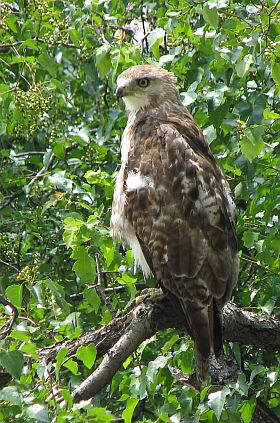 The nest is empty.
The nest is empty.
Last week two red-tailed hawks took their first flight from the nest near my office. Several things intrigued me about the way they did it.
First, it took them two weeks to progress from flapping hops to flying away. This seemed to take only a week for the peregrines. Perhaps the learning curve for red-tails is longer because they’re larger and heavier.
Then, in their first flights the red-tails refused to land on trees. Instead they flew to WQED’s building, our satellite dish and a TV antenna. I expected them to land in the trees near their nest but I guess they thought the trees looked scary because they grew up in a gutter.
And then there was the whining. When they were nest-bound I never heard them make a sound. After they flew they became very noisy about food. I found them easily last Friday because they were whining from the floodlights.
So now there are four large, similar-looking hawks outside my office window. How do I tell the difference between the adults and their kids?
As you can guess, behavior is a huge hint. The babies beg and the adults supply food. But what if they’re perched alone?
The easiest field mark is their tail. I’ll use this photo of an immature red-tailed hawk by Jamey Stewart to illustrate. Notice that this bird’s tail, protruding below his two wing tips, is brown with faint horizontal stripes. An adult red-tailed hawk has a rusty red tail. It’s that easy – red versus brown.
There’s one gotcha about this bird that you can’t see here. Jamey sent me two photos of the immature red-tail that visited Duquesne University’s campus last week. One showed the bird’s back and there I clearly saw half-grown rusty red feathers, hidden by his wings in the photo above.
So this immature bird is not a fledging. Chuck Tague says they begin to grow red tail feathers at about one year old. Red-tailed hawks take 3-4 years to mature so this bird has some years to go before he’s an adult.
p.s. Thanks to Chuck for clarifying the age at which the red tail feathers grow. I also learned that immature red-tails have yellow irises (eyes). See above! When red-tailed hawks mature their eyes change to a dark rusty color.
(photo by Jamey Stewart)
Interesting stuff, Kate! We had a pair of red-tails in our neighborhood for a couple of years and they cleared the over population of rodents very nicely. They were a joy to watch. When we again become overrun, I suspect they’ll be back. Nature’s way is fascinating.
I really enjoy your blog and check it often. This is unrelated to your latest entry, but I have noticed quite a change in the birds that frequent my backyard feeder. Earlier in the Spring/Summer, I got a huge variety – blue jays, cardinals, finches, chickadees, doves, sparrows, etc. I put out a variety of foods and everyone found something that they liked. For the last 2 weeks or so, I am only getting blackbirds. I will get a few at a time, or as many as 15 at a time, all feeding in the same small area. All are about robin/blue jay in size. Half of the birds are black/brown with a blue/black iridescent head. The other half of the population are all-over brown. Is this male/female or two different types of birds? And, where have all of the others gone? Have their nesting and family needs changed and they are on to other places, or do they not need to stop by so much to feed their littles ones, combined with other food sources now that Summer is here? Are the black birds scaring them away, even though there are many times that the feeder is empty?
I was just curious if there is more to what I see in my backyard every day.
Susan, you have common grackles in your yard. The adults have iridescent heads, the young are brown all over. Grackles often nest communally in large evergreen trees. Perhaps there are spruces in your neighborhood. It sounds like the young have just fledged from several grackle families bringing many to your feeders.
I am not sure why you aren’t seeing other species at the feeders right now. I can understand why they wouldn’t visit while so many grackles are there, but if you don’t see any others at all it is probably the breeding/family stage they’re currently in. Many birds – cardinals and robins, for instance – lay two sets of eggs per season. The first brood is fledged and on their own, the second brood is still in the egg stage so the adults are incubating eggs and won’t be at the feeder as often.